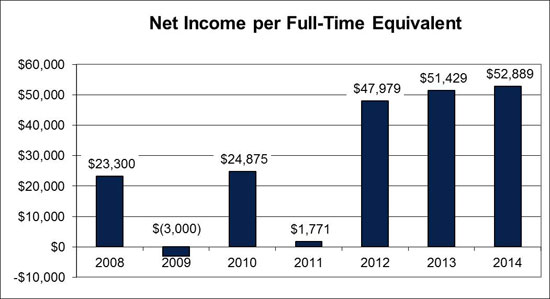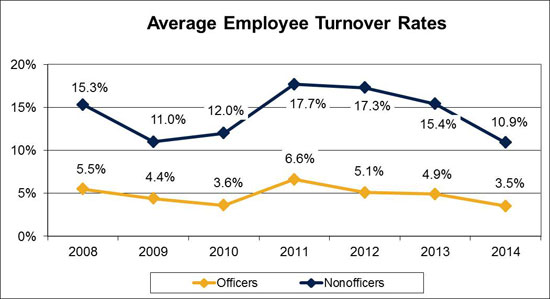Does your compensation policy work for you?
Part 4: Can you compute “Human Capital ROI” for your bank?
- |
- Written by Crowe Horwath Compensation Study

For the third year we present exclusive reports on this website from Crowe Horwath LLP from its annual Financial Institutions Compensation and Benefits Survey. To review last year’s series and recommendations, see Crowe Horwath Compensation Study.
When assessing the effectiveness of any given strategy, the ultimate question is, “Is the strategy achieving the goals we defined?” In the case of financial institutions’ compensation strategies, that question can be hard to answer because the goals often are defined only in general terms, with few specific metrics to measure a strategy’s effectiveness.
Each year, the Crowe Horwath LLP Financial Institutions Compensation and Benefits Survey queries financial institutions throughout the United States about compensation trends, benefits, incentives, and other human resources issues. This article, the conclusion of a four-part series on the results of the 2014 survey, will look at some ways banks can use survey results and other data to assess the effectiveness of their compensation strategies.
Defining the strategy: a total rewards approach
The first step in determining whether a compensation strategy is achieving its intended goals is to make sure there’s clarity regarding exactly what those goals are. That includes clearly defining the strategy’s scope, which in today’s environment generally involves much more than just pay.
As explained in the first article of this series, “Bankers work for way more than pay,” one of the most widely recognized methods for evaluating the entire employment relationship is the total rewards approach advocated by WorldatWork, a leading not-for-profit human resource organization. The total rewards model encompasses five elements:
1. Pay and financial incentives
2. Healthcare, savings, and retirement benefits
3. Work/life balance programs
4. Performance incentives and recognition
5. Development and career advancement opportunities
When evaluating the effectiveness of the compensation strategy, it is important to consider the costs and benefits of all elements of the package—not just pay alone.
Defining success: key performance measures
Once the scope of the compensation strategy is defined, the next step is to define the key performance measures (KPMs) that will be used to assess its success. Because the mission of the human resources function typically is defined in terms of three general goals—attracting, motivating, and retaining employees—it makes sense to organize the KPMs in the same way:
1. Attracting employees
A compensation strategy’s effectiveness in attracting employees is reflected in the time it takes to fill job openings and in the quality, capability, and competence of the candidates expressing interest in those openings. Measuring the time needed to fill a job is a relatively straightforward process, but evaluating the quality of candidates can be a bit more challenging.
The best metrics are objective and not open to interpretation. Monitoring year-to-year trends in standardized test scores for all new hires is one example. Other possible metrics include tracking how many new hires leave within the first year of their employment and examining the one-year anniversary performance ratings of those employees who stay.
Adverse trends in these metrics could reflect shortcomings, such as inadequate training or poor front-line management, which are beyond the scope of the compensation strategy. Nevertheless, declining candidate test scores, a growing dropout rate, or declining performance ratings of first-year employees could be signs that the compensation strategy is not keeping pace with today’s changing workforce.
2. Motivating employees
Measuring employee motivation can be difficult. Standard performance metrics can be a good place to start because employees who are motivated generally will be engaged in their jobs and more likely to do good work.
One commonly used measure of overall productivity is net income per employee— dividing the bank’s net income by the total number of full-time equivalent (FTE) staff. This produces a metric that is consistent and easy to measure.
For example, in this year’s survey, respondents reported average net income of $52,889 per employee across the entire population. Tracking this metric over a period of years, as shown in Exhibit 1, clearly shows the roller-coaster effect of the recession years, followed by a three-year trend of steady recovery.
Exhibit 1

A similar year-over-year comparison within an institution would provide an ongoing measure of overall employee performance across the entire enterprise. However, any conclusions would need to be tempered by other factors, such as a rebound in profitability stemming from the cleanup of loan portfolios during 2011-2012.
This points out one of the shortcomings of using broad measures of overall employee performance to gauge employee motivation: They can be too general to provide useful information.
Conversely, many worker productivity metrics are designed to reflect the specific job requirements of each position. This makes it difficult to establish a consistent institutionwide measure of performance. To genuinely understand if a compensation strategy is working, it often is necessary to look beyond internal HR metrics alone. Talking directly to line management about the employee motivation indicators they see every day can help.
3. Retaining employees
The most basic measure of a compensation strategy’s success in retaining employees is the overall employee turnover rate. The Crowe Compensation and Benefits Survey tracks this information annually, providing insights into the general state of the banking workforce on a national basis.
For example, the 2014 survey reveals a three-year downward trend in turnover among both officers and nonofficers, presumably indicating a stabilizing industry and workforce.
Exhibit 2

In addition to tracking overall industry trends, the survey results are broken down by several criteria, allowing a bank to compare its turnover rate with peers of similar asset size or with other banks that serve communities of comparable population.
Within each institution, even more useful information can be discovered by comparing turnover rates for specific job positions, making it possible to develop retention targets for critical positions or departments. For example, a bank might decide it can tolerate relatively high turnover among teller staff while setting a much lower turnover target among lending officers and staff.
Broader measures of success: human capital metrics
To fully evaluate whether a compensation strategy is working, it can be helpful to move beyond traditional human resource metrics such as head count, absenteeism, and turnover, all of which focus on costs, and instead consider measures known as human capital metrics, which measure the value the workforce adds to the organization.
The Society for Human Resource Management defines human capital as “the collective knowledge, skills, and abilities of an organization’s employees,” building on the idea that by investing in these employee attributes, organizations can create economic gain. The net income per employee metric discussed earlier (Exhibit 1) reflects this thinking, but an even more revealing human capital metric is called human capital return on investment (HCROI).
HCROI is calculated by first determining the additional profit an institution generates from its operations over and above an agreed-upon minimum return that it could reasonably expect from a conventional investment of capital. This added value is then divided by the total investment in personnel expenses, including compensation, recruitment, training and development, and employee welfare.
When tracked over time, or when compared with other institutions of similar size, this metric can help management quantify the value that is being added by its human capital initiatives and provide an objective answer to the question, “Is our compensation strategy achieving the goals we defined?”
Finally, don’t ignore obvious signs that a compensation strategy is not working. If competitors regularly lure away top-performing employees, or if a bank must compromise its hiring standards just to fill vacant slots, then management faces a crucial decision: It must decide whether to change the strategy because it no longer meets the bank’s needs, or to change the tactics it employs to achieve the strategy it has set.
Share your bank’s compensation innovations and solutions in the comment section below.
Tagged under Human Resources, Management, CSuite, Community Banking, Feature, Feature3,














